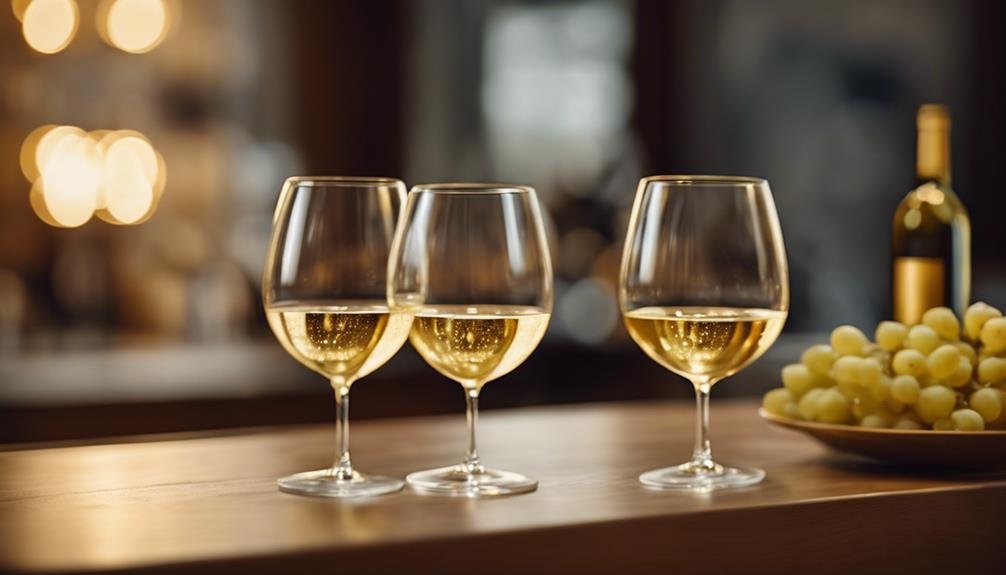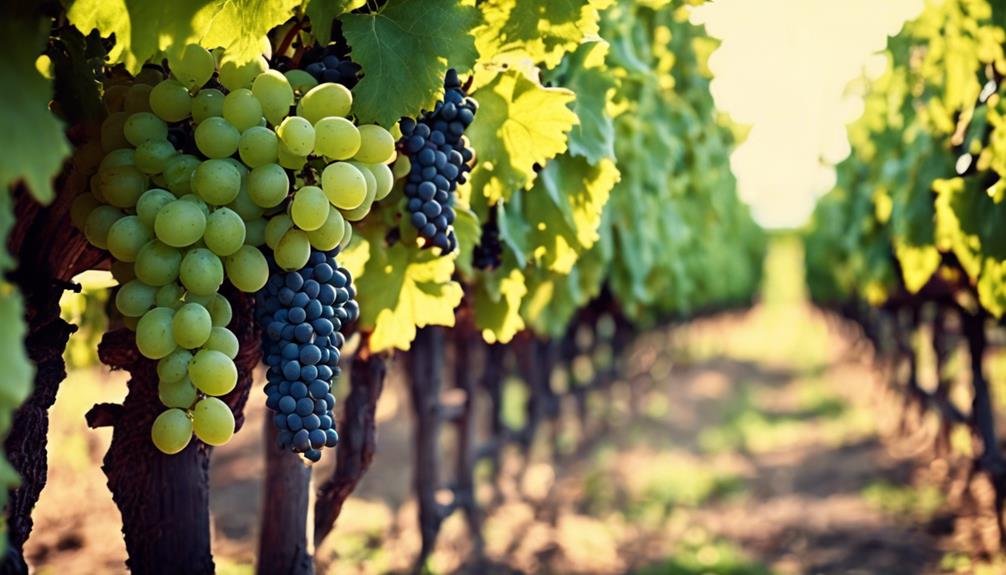Exploring Chardonnay reveals the vast world of this celebrated white grape variety. Known for its adaptability, Chardonnay thrives globally, especially in regions like California, offering a diverse array of styles to captivate wine lovers. From buttery oaked expressions to zesty unoaked varieties, the grape presents a spectrum of flavors from citrusy notes to tropical fruitiness. Pair it with foods like cheese, seafood, poultry, or vegetarian dishes to elevate dining experiences. Explore the versatility and richness that Chardonnay brings to the table, enticing palates with its charm and character. Discover the nuances of this wine lover's paradise.
Chardonnay: A Versatile White Grape
Chardonnay stands as the epitome of versatility among white grape varietals, showcasing a remarkable range of expressions that captivate wine enthusiasts worldwide. Its global popularity is evident through being the most diverse and widely planted white wine grape globally.
Chardonnay production thrives particularly in regions like California, boasting more plantings than any other grape. The allure of Chardonnay lies in its ability to offer a wide variety of styles, ranging from buttery oaked expressions to zesty unoaked profiles. This adaptability makes Chardonnay a favorite choice for many, as it can cater to different taste preferences with finesse.
Whether from warmer regions like Napa Valley or cooler climates like Sonoma Coast, Chardonnay continues to entice palates with its rich and varied character.
Exploring Chardonnay Food Pairing
When considering ideal food pairings for Chardonnay, it is essential to explore complementary flavors that enhance the overall dining experience.
Here are some key pairings to elevate your Chardonnay enjoyment:
- Chardonnay cheese pairings: Soft cheeses like Brie or Camembert complement the creamy texture and subtle flavors of Chardonnay.
- Chardonnay seafood matches: Delicate seafood dishes such as grilled shrimp or lobster pair beautifully with the crisp acidity and citrus notes of Chardonnay.
- Chardonnay poultry partners: Chicken piccata or roasted turkey dishes harmonize with the fruity and sometimes buttery profile of Chardonnay.
- Chardonnay vegetarian options: Vegetable risotto or butternut squash ravioli provide a flavorful match for Chardonnay's versatile character.
Decoding Buttery Chardonnay Styles

Revealing the nuances of buttery Chardonnay styles exposes the intricate balance between oak influences and grape characteristics. Oak-aged Chardonnays offer a rich, full-bodied experience, often showcasing flavors like vanilla and caramel. This style is achieved through oak barrel fermentation, imparting a buttery texture and taste.
In contrast, unoaked Chardonnays lean towards zesty profiles, resembling wines like Pinot Gris or Sauvignon Blanc. The absence of oak allows the grape's natural fruity flavors to shine, ranging from lemon to pineapple notes.
While oaked Chardonnays are prevalent in warmer regions like Napa Valley and Burgundy, unoaked varieties are commonly found in cooler climates such as Sonoma Coast and Loire Valley. Understanding these distinctions between buttery and zesty Chardonnays can enhance your appreciation of this beloved wine.
Discovering Unoaked Chardonnay Varieties
Discovering the world of unoaked Chardonnay reveals a spectrum of invigorating and fruit-forward expressions that showcase the grape's inherent characteristics without the influence of oak aging.
- Unoaked Chardonnay offers a revitalizing alternative to the buttery styles often associated with oak-aged versions.
- Citrusy elegance defines many unoaked Chardonnays, with notes of lemon, grapefruit, and lime taking the spotlight.
- Fresh fruitiness abounds in unoaked Chardonnay, with flavors ranging from crisp green apple to tropical pineapple.
- Unoaked Chardonnays typically hail from cooler climate regions, preserving the grape's natural acidity and bright fruit profile.
Exploring unoaked Chardonnay varieties can lead to delightful encounters with wines that emphasize purity, vibrancy, and a true reflection of the Chardonnay grape's essence.
Spotlight on Madeline Puckettes Wine Journey

Madeline Puckette's wine journey exemplifies a dedication to wine education and communication, earning her accolades and recognition in the industry. Through her work with Wine Folly, Madeline Puckette has provided valuable insights into the world of wine, making complex concepts accessible to all enthusiasts.
Her active engagement with the Wine Folly community has created a platform for sharing knowledge and fostering a love for wine. By leveraging social media and her website, Madeline Puckette has successfully cultivated a space where individuals can learn and appreciate the nuances of wine in an engaging manner.
Her contributions to the industry have not only been acknowledged but also celebrated, solidifying her position as a leading figure in the world of wine education and communication.
Frequently Asked Questions
Can Chardonnay Grapes Be Used to Make Sparkling Wine?
Yes, Chardonnay grapes are commonly used in making sparkling wine. Blending techniques and harvest timing play vital roles in creating sparkling Chardonnays. The grape's versatility allows winemakers to craft a range of sparkling styles.
Are There Any Vegan-Friendly Chardonnay Options Available?
Vegan-friendly Chardonnay options are available, with wineries increasingly adopting animal-friendly production practices. These Chardonnays pair well with plant-based dishes, offering a delightful experience for wine enthusiasts seeking ethical and sustainable choices.
How Does Chardonnay Age Compared to Other White Wines?
Chardonnay's aging process varies based on style; oaked versions develop richness with vanilla notes, while unoaked remains zesty with citrus flavors. Proper storage, at consistent cool temperatures, is essential for preserving Chardonnay's delicate flavors and ensuring best aging.
What Impact Does Soil Type Have on Chardonnay Flavor?
The flavor profile of Chardonnay is greatly influenced by soil type, known as terroir, impacting acidity levels. Climate plays an essential role in shaping minerality in Chardonnay. Understanding these factors enhances appreciation of the wine's complexities.
Is There a Significant Difference Between Organic and Non-Organic Chardonnay?
Taste differences between organic and non-organic Chardonnay can be subtle, influenced by production methods. Consumer preferences drive demand for organic wines due to perceived environmental benefits. Understanding these nuances enhances appreciation for Chardonnay varietals.
Conclusion
In the vast vineyard of life, Chardonnay stands as a beacon of versatility and elegance, offering a paradise for wine lovers to explore. From the buttery depths to the zesty heights, each sip reveals a new chapter in this enchanting tale.
As we raise our glasses to this noble grape, let us toast to the artistry of Chardonnay and the endless possibilities it holds for those who seek to discover its mysteries. Cheers to the journey ahead!
